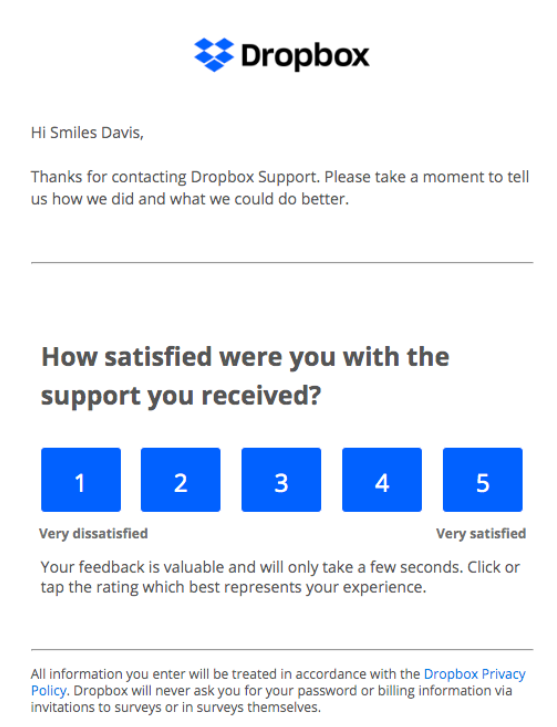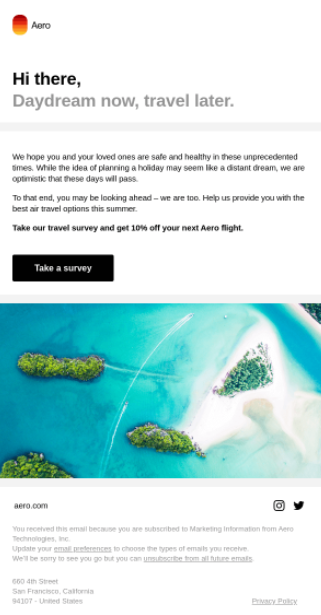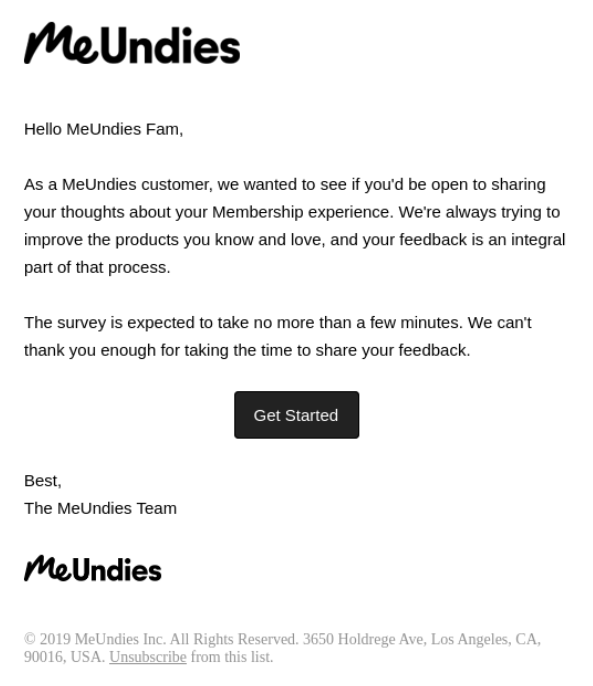A few decades ago, the price was the main criterion prospects relied on when choosing a consultant or a business coach. The good news is, this is no longer the case.
In 2021, customer service strategies and satisfaction are the pillars of client retention and growing revenues.
How can managers track customer satisfaction? Running email surveys and directly asking clients for feedback is an effective and easy-to-implement strategy. In this post, we will take a look at how to survey customer satisfaction.
We’ll look into how to write a good copy that doesn’t annoy a recipient. We’ll share some email delivery tips and ready-to-deploy email templates.
What is customer satisfaction?
By definition, customer satisfaction is the degree to which a client is happy with a product or a service. Basically, the concept gauges out how much value your clients get out of the interaction with you personally or the company.
In the age of remote communication, measuring customer communication is not easy. In messages or on phone calls, clients might hold their frustrations back only to share them later on social media or spread negativity around your brand in their social circles.
That’s why, in 2021, business owners should go the extra mile to measure customer satisfaction. In the long run, thoroughly gathering customer feedback helps company managers reach the following objectives:
- Identifying unhappy customers and addressing their objections and frustrations to keep clients coming back for professional advice.
- Getting constant feedback that points business owners to new market trends and helps them stay one step ahead of competitors.
- Discovering expansion opportunities through talking to clients about their expectations in brand interactions.
The key objective of customer satisfaction is retention.
Although it takes extra work, keeping a client loyal to the company is statistically 82% cheaper than onboarding a new one.
How to measure customer satisfaction?
Marketers have metrics to measure most customer-brand interactions. We know how much time prospects take to make informed decisions, see how first-time website visitors browse landing pages, and can even predict the conversion rate of a blog post or advertising campaign.
But when it comes to measuring emotional response, we have no idea which metrics or tools are helpful. After all, even the most loyal clients can be unhappy with the quality of service and keep considering alternatives. As soon as customers come across a suitable replacement, you never hear from them again – that’s a frustrating way to lose clients.
How to spot red flags in customer interactions and discover concerns in their seed stage? There’s a widely accepted and fairly effective practice to monitor customer satisfaction – surveys.
Customer satisfaction surveys are questionnaires that help business owners collect raw and unbiased feedback from customers. If intelligently designed, every question should reflect what clients really think about the brand, without leading respondents into the trap of canned replies.
By “intelligently designed”, we mean surveys that give company managers the following insights:
- What are a customer’s key needs and expectations for the interaction with a consultant?
- What market trends emerge from interactions with customers?
- Where does the company fall short?
- How can company managers improve customer experience and the quality of the interaction?
Strategies to reach out for feedback
So, you are dead-set on creating a customer survey and sharing it with your customers. Then, the next step is how you can get in touch with customers without being “on the nose”.
There are different ways to seamlessly integrate feedback surveys in different touch points across customer journeys. Choose your favorite:
1. In-app notifications
If you run a product, adding a customer survey pop-up is a creative way to encourage users to take some time and reflect on their in-app experience. Asana – a project management software – is a spot-on example of skillfully using in-app notifications.

As you are using the platform, the pop-up will show up and ask “How likely are you to recommend Asana to friends and colleagues?”. In-app users will be able to quickly answer the question by choosing numbers from 1 to 10, indicating whether or not they are likely to seek out an alternative to Asana.
Benefits of in-app customer satisfaction surveys:
- Smoothly integrates into the user experience.
- Won’t bother users or come across as spam.
- Has a high probability of reaching your audience (no external spam filters).
Drawbacks of in-app customer satisfaction survey:
- You need to have an app. If your brand doesn’t have a product, there’s no way to leverage built-in pop-ups.
- In-app customer feedback surveys are typically short. It’s highly unlikely that a user will stop his interaction with the coach or education content to fill out a 7-10 minute survey. That’s why business managers have to cut their questionnaires short and add only the essential ones.
- Limited analytics. Compared to customer satisfaction emails that are connected to a wide range of marketing tools, there are fewer tools to analyze the audience’s interactions with an in-app pop-up.
2. Customer satisfaction survey emails
Emails are another strategy marketers swear by when it comes to collecting customer feedback. A lot of companies from Amazon to Netflix share transactional emails with clients to find out if shoppers or users enjoyed their interactions with the brand.
Consulting business owners can take pointers and consider adding customer satisfaction survey emails to their market strategy.
Benefits of customer satisfaction emails:
- Personalization. An important asset in the consulting industry is personal client contact. Compared to in-app pop-ups, customer satisfaction surveys can seem almost tailor-made for each client. From customers’ names to specific session details (date, time, duration), consultants can create personalized messages that help foster a deeper connection between customers and the brand.
- Functionality. Using email for sharing customer surveys empowers business owners with a wide range of tools – from basic, plain-text layouts to visually rich HTML platforms. A creative approach to customer surveys can help business owners keep clients’ attention focused on answering questions for up to 10 minutes. If you have started to send customer survey emails, don’t forget to check your email deliverability conditions.
- Analytics. By using an ESP (Email Service Provider) to run and manage customer satisfaction campaigns, business owners get a full view of how readers interact with each message. You’ll find out which devices people use to interact with reviews, how often they click on links, and how much time completing a survey takes. This granular data helps marketing teams and business owners improve the precision of questionnaires by removing redundant questions or giving customers an easier way to express feedback.
- Spread your questions over multiple mails. It doesn’t have to be an all-in-one email. Sharing long customer surveys in one message might seem overbearing – and it is! The good news is, you don’t have to overwhelm clients with huge emails. It’s common for business owners to spread feedback sessions over a campaign containing 8-10 emails. In this case, each message will feature 1-2 questions at best and will be easy to answer.
Drawbacks of customer feedback survey emails:
- High risks of email bounce and spam flagging. To ensure email deliverability, marketers need to have a well-fleshed technical infrastructure and be mindful of the words they use in the copy (phrases like “buy now”, “Get one for free”, and others are marked by email service providers as suspicious and get trapped in Promotions or Spam.
- Takes time to design. Marketing teams should be aware of the time and effort required to build an email layout and customize it for mobile.
- Privacy issues. If you get on customers’ nerves by using their emails to send one survey after the other, clients might be hesitant about sharing personal data in the future.
Generally, we prefer using emails for customer surveys over in-app pop-ups, mainly because there’s more room for analytics and transparency, a higher range of visual and functional tools, and there’s no need to have a product to implement this strategy.
Now it’s time to find out how to write customer satisfaction, onboarding and welcome emails your customers cannot ignore.
How to write an email for customer satisfaction surveys
As you are writing a customer satisfaction survey email, remember that its main goal is to tell a client that giving feedback on sessions with the company won’t take a lot of time ànd is extremely valuable to the organization.
A small point that may seem obvious but is often overlooked, is to make sure you send your email from the official business email address and not your work email address within the company. The customer needs to feel like their feedback is valuable to the organization as a whole and not a particular person within the company. Customer loyalty should remain with the business irrespective of who’s handling the individual customers. Though small, this step makes a big impact on customers.
How do you communicate the feeling of appreciation for a customer’s voice? I recommend sticking to these tried-and-true tips (feel free to use survey templates as well).
1. Be personal
If you want clients to spend their time sharing feedback, take the first step and put the effort into calling customers by names. Instead of “Dear Sir” or “Dear Client” (I still get these every once in a while), say “Hello” in a personalized and believable way:
- Hey, Sam
- Dear Ms. Johnson
- Hi, Sam.
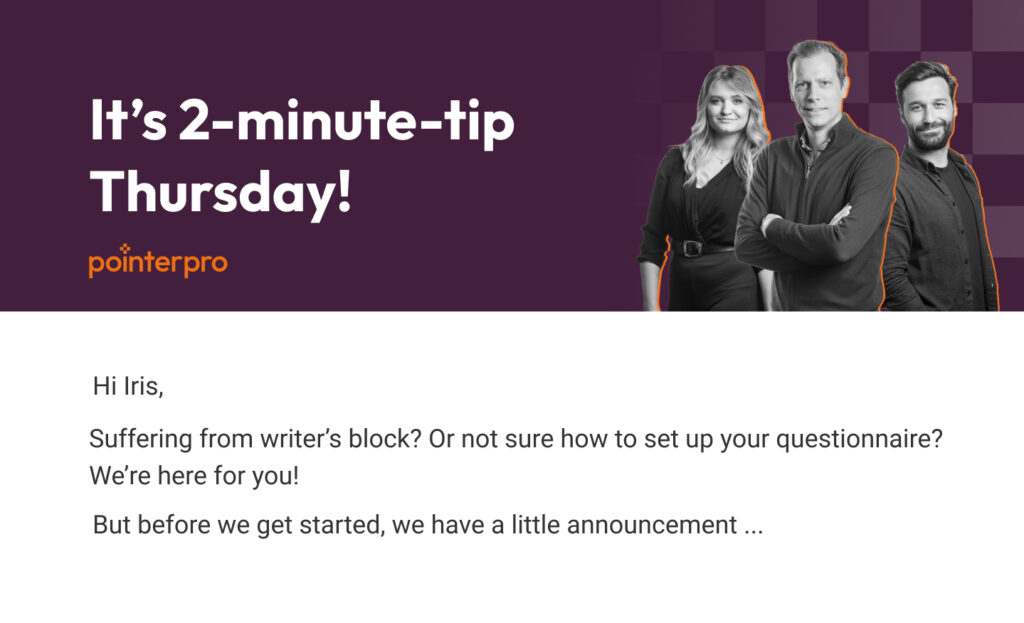
2. Provide context
Here’s a smart way to make a customer feel like he cannot back off from the survey – write a paragraph or two about why you asked this specific person for an opinion on the brand.
There could be as many reasons as you can come up with: a long history of brand interactions, positive aftertaste during sessions that makes you feel like the client can share a well of insight, and so on.
Here’s an example you can tweak and use as a customer satisfaction survey email template:
“Hi [First Name],
I enjoyed working with you for the last [period of time].
Since you brought up a lot of insightful ideas during our coaching sessions, I was wondering if you could share your impression on working together and suggest a few ideas that help [organization name] improve.”
3. Outline the structure of the survey
Now that the reader is motivated to take a closer look at the survey and empowered to help your business, it’s time to guide a customer through the process. Give a clear description of the questionnaire and back it up with a realistic (!) time estimate.
Here’s what I mean:
“The survey has [question number] [question type] questions you can answer by completing the questionnaire. Typically, it takes about [amount of time] minutes to fill in the full form”.
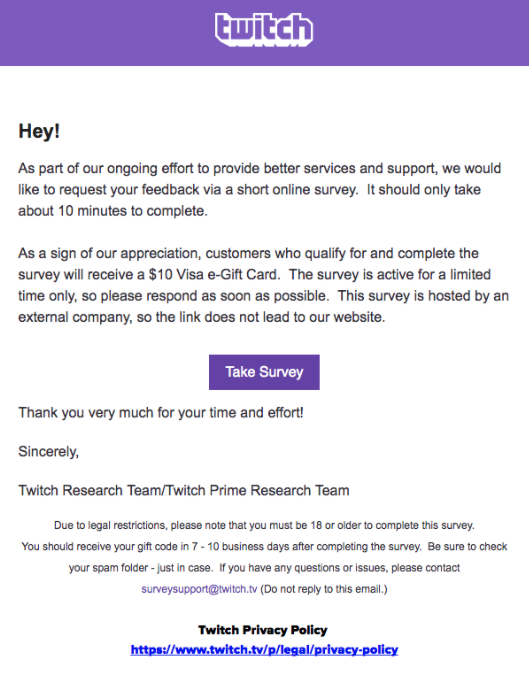
4. Include a link to the survey
After explaining the process, share a direct URL to the survey or hide it behind a good-looking button. I don’t recommend relying on link shorteners for several reasons:
- ISPs don’t like them so your email will have higher odds of getting flagged as spam.
- Users are suspicious of them after seeing a lot of untrustworthy bit.lys on Facebook or Twitter.
- A direct link gives more information about the survey (e.g. which platform you use to collect feedback), subtracting from confusion a customer might feel).
Here’s an example, in case you need one:
“Here’s the link to the survey form (I did my best to keep it short): [link].”
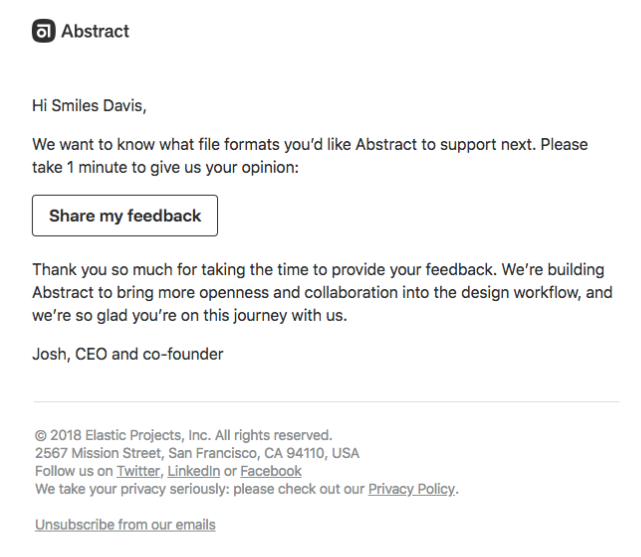
5. Thank the client and sign off
By the way, having a customer satisfaction survey is a great newsletter idea as well.
Finally, don’t wait until the client completes the survey to show gratitude. After all, spending a few minutes to open and read a survey message to customers deserves a “thanks”.
Here’s how you can show appreciation to a customer in a survey email:
“I’d like to note that I’m really enjoying our collaboration and hope to keep working together. Let me know how I can improve and help you get the most out of our collaboration.”
And then sign off in your preferred way, with a simple or CEO email signature depending on how official you want to make the mail.
Best customer satisfaction survey emails
To get a few creative ideas that will help you “lure” customers in to take your survey, take a look at these creative customer satisfaction survey email examples:
1. Aero
Although this has nothing to do with customer satisfaction surveys, there are more than a few pointers to take from Aero:
- Stay in touch with your customer’s reality. the company does it by expressing concerns for clients’ health and referencing the challenges of “these unprecedented times”, referring to the pandemic in 2020.
- Incentivize survey takers. Areo does that by offering a 10% discount.
- Keep your copy short. Areo’s email takes minutes to skim through.
2. Ritual survey invitation
Ritual sends users a simple but sincere customer satisfaction email survey. From the get-go, the company states: “Your opinion will help us improve”. That makes customers feel relevant and valued and assigns meaning to the process of completing a survey.
Notice that Ritual also emphasizes how short and easy to take a survey is by saying: “We promise it will only take a few minutes”.
3. MeUndies
MeUndies is another example of to-the-point survey invitations. Frankly, the content itself is nothing much but the layout and design are worth giving credit for. The company chooses a sleek, well-branded, yet simple layout to invite customers to share their opinion of MeUndies.
Also, the design team managed to attract quite a bit of attention to the signature by adding a logo to the section, with the help of an email signature generator.
Conclusion
Customer satisfaction is not an easy-to-track metric but its impact on business growth is so astonishing that business owners should find ways to gauge out customer feedback.
Customer satisfaction survey emails are a way to ask customers for thoughts and ideas.
Once you have your email structure hammered down, all that is left are design tweaks and the technical infrastructure to support the campaign. Good luck!

